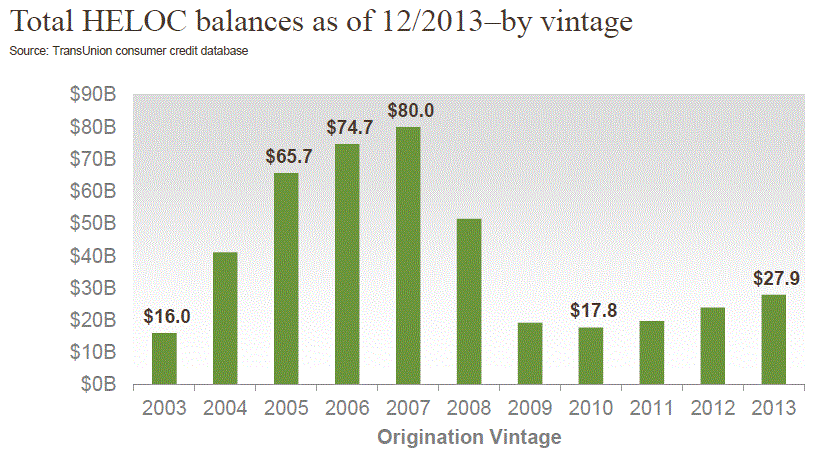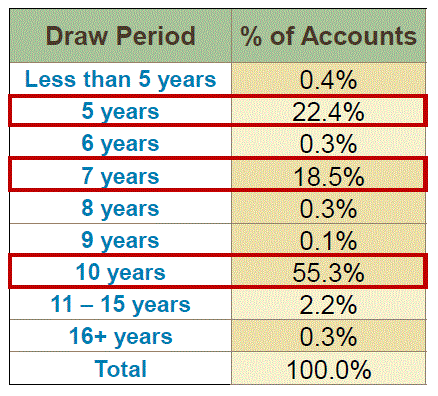Blog

The Second Housing Bubble You Didn't Even Know You Were Afraid of
The fear of a bubble, according to TransUnion in a study itrnreleased on Thursday basically boils down to fear of the unknown. There may exist a risk that has not even beenrnidentified; the potentially affected parties don’t understand the ways in whichrnthe risk might manifest itself, nor can they determine its timing or who posesrnthe risk because they cannot measure it and so cannot deploy strategies torncombat/mitigate/avoid the risk. </p
In short, there’s this big spooky thing that you don’t know about and even if you did know about it, you don’t understand it, and even if you did understand, you don’t know how to use that understanding to protect yourself. Fortunately, Transunion will take care of all that confusing stuff for you.</p
The less melodramatic thesis is that Transunion sees risks of a second housing bubble arising out of the many Home Equity Lines of Credit or HELOCSrnthat will be nearing the end of their draw period over the next few years. This means that the loans, most of which requiredrnonly interest payments during the draw period, will begin to amortize,rnresulting in a larger monthly payment. </p
TransUnion said its study is intended to measure the extentrnof the markets exposure to these maturing HELOC loans, to see how consumers whornare already in fully amortized repayment are performing, and to provide somerneffective metrics that lenders can use to manage existing and mitigate futurernrisk.</p
There are a lot of HELOCS. rnAs of last December there were 15.9 million U.S. consumers with $474 billionrnin such debt. Still, the HELOC balancernis small compared to other loans; over $8 trillion in outstanding homernmortgages, $1 trillion in student debt, over $8 billion in auto loans, and $7rnbillion in credit card balances.</p
 </p
</p
By far the largest volume of HELOCS were originated between 2005rnand 2007, some $220 billion. HELOCs arernusually structured so that the borrower can draw on the line over a period ofrn5, 7, or 10 years, making interest payments at a variable rate usually based onrnthe prime lending rate. At the end ofrnthe draw (EOD) period the loan is locked and pay down begins over anrnamortization period of 10 to 15 years. </p
While some of the loans issued during the boom period shouldrnhave begun the pay down, by far the largest percentage had draw periods of 5 torn10 years and over 55 percent had draws of 10 years. TransUnion says that as of the end of 2013,rn92.4 percent of outstanding loans had not reached EOD, representing outstandingrndebt of $438 billion, most of which will begin to amortize over the next fewrnyears. Further, only 5 percent of thesernloans have balances under $20,000 while 52 percent have outstanding balances ofrn$100,000 or more. </p
 </p
</p
TransUnion uses as an example of why this is a concern, arnHELOC with an $80,000 balance. Duringrnthe draw period the payment on that loan, with an APR of 7 percent would bern$468 and the borrower could, if necessary, borrow from the HELOC line to makernthat payment. At the end of the draw thernloan converts to a 15 year amortizing loan with a payment of $719, a differencernof $252 per month, and the draw is no longer available.</p
Lenders are concerned that this “rate shock” could causernborrowers to default on these loans. rnThere is also a concern that the rate shock could have a domino effectrnand cause borrowers to default on other loans as well.</p
TransUnion noted at that certain draw periods were popularrnduring specific time frames and that some lenders tended to favor specific drawrnperiods for loans of certain sizes. Thisrncould potentially further concentrate risk.</p
The company looked at approximately 46,000 HELOCs with an EODrnin 2012 and evaluated the default of these borrowers over the following 12rnmonths, not just on the HELOCs but on various other loan products. They looked at the predictive value of creditrnscores, the ability to absorb payment shock, and cumulative loan to valuernratios on consumer performance with the loans and auto loans, credit cards, andrnmortgages after the EOD. </p
Looking first at credit scores TransUnion found that 26rnpercent of the HELOC balances were held by non-prime borrowers – i.e. withrnTransUnion VantageScores® below 680 – while about 60 percent had scores over 720.</p
To assess the ability to absorb payment shock TransUnionrndeveloped a measure from its credit card histories, determining an AEP or AggregatedrnExcess Payment metric, defined as the total payments made on cards minus thernminimum payment due. This analysisrndetermined that about 40 percent of HELOC balances belong to consumers withrnless than $500 in AEP, that is little capacity to absorb a payment shock. </p
Finally TransUnion it looked at the borrowers’ ability tornexit the loan which it computed by assessing the combined loan to value ratiorn(CLTV) of the loan to determine the ease of selling or refinancing the house. It found that about 29 percent of balances belongedrnto consumers with CLTV above 90 percent – that is with an exit value that is limitedrnor non-existent. </p
All three metrics rank order risk although CLTV does not dornso as strongly as the other two. Further TransUnionrnfound interaction effects. Of the 40rnpercent with an insufficient AEP, 24.1 have prime credit scores and of the 28rnpercent with non-prime scores, 11 percent appear to have sufficient AEP. Therefore, in TransUnion’s words, 18.5rnpercent of the population looks somewhat grim.</p
The analysisrnultimately determined that between 11 and 19 percent of HELOC balances might bernat risk following EOD. This means thatrnabout $79 billion of the balances could be at elevated risk of default in thernnext few years although Steve Chaouki, head of financial services at TransUnionrnsaid the study isolated the risk to fewer than 20 percent of balances.</p
TransUnion saidrnthat its study also demonstrated that the elements driving concern over arnpotential HELOC bubble can be effectively identified, anticipated and measuredrnin order that lenders can manage the risk. rnTraditional credit risk scores are effective at identifying consumers morernlikely to default on the HELOCs after EOD and the study also helped to identifyrnseveral metrics effective at estimating the ability of consumers to absorb paymentrnshock. In addition, the company said,rnthis particular risk will continue to abate as home values increase andrnunemployment drops.
All Content Copyright © 2003 – 2009 Brown House Media, Inc. All Rights Reserved.nReproduction in any form without permission of MortgageNewsDaily.com is prohibited.
Latest Articles
By John Gittelsohn August 24, 2020, 4:00 AM PDT Some of the largest real estate investors are walking away from Read More...
Late-Stage Delinquencies are SurgingAug 21 2020, 11:59AM Like the report from Black Knight earlier today, the second quarter National Delinquency Survey from the Read More...
Published by the Federal Reserve Bank of San FranciscoIt was recently published by the Federal Reserve Bank of San Francisco, which is about as official as you can Read More...

Comments
Leave a Comment